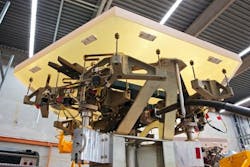Physik Instrumente to build position actuators for primary mirror of ESO's ELT
ESO, the European Southern Observatory, has signed a contract with the Physik Instrumente (PI; Karlsruhe, Germany) to construct the position actuators (PACTs) that will adjust the positions of the 798 hexagonal segments of the primary mirror of ESO’s Extremely Large Telescope (ELT). The segments that make up the ELT’s 39-m main mirror will be connected to the main telescope structure via a support system (ann15003), of which the PACTs are fundamental components.
Each segment of the ELT--approximately 1.4 m across and weighing 250 kg--will be mounted on three PACTs, for a total of 2394. The PACTs will support the segment and actively control its position in three directions, known as piston, tip, and tilt. The control system of the ELT primary mirror will initiate tiny adjustments to the PACTs to maintain the mirror’s overall shape, correcting for deformations which may be caused by changes in telescope elevation, temperature, and wind forces, as well as limiting the effects of vibrations.
Physik Instrumente has worked with ESO before, providing the hexapods that align the subreflectors to the large main reflectors of the radio telescopes that make up the Atacama Large Millimeter/submillimeter Array (ALMA). ESO (formally known as the European Organisation for Astronomical Research in the Southern Hemisphere) is headquartered in Garching, Germany, and is an inter-governmental organization supported by 16 Member States, along with the host state of Chile. The current Director General is Prof. Tim de Zeeuw.
Source: ESO

Conard Holton
Conard Holton has 25 years of science and technology editing and writing experience. He was formerly a staff member and consultant for government agencies such as the New York State Energy Research and Development Authority and the International Atomic Energy Agency, and engineering companies such as Bechtel. He joined Laser Focus World in 1997 as senior editor, becoming editor in chief of WDM Solutions, which he founded in 1999. In 2003 he joined Vision Systems Design as editor in chief, while continuing as contributing editor at Laser Focus World. Conard became editor in chief of Laser Focus World in August 2011, a role in which he served through August 2018. He then served as Editor at Large for Laser Focus World and Co-Chair of the Lasers & Photonics Marketplace Seminar from August 2018 through January 2022. He received his B.A. from the University of Pennsylvania, with additional studies at the Colorado School of Mines and Medill School of Journalism at Northwestern University.
